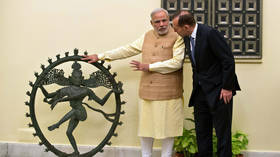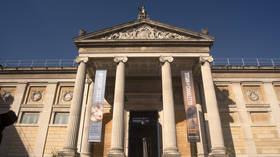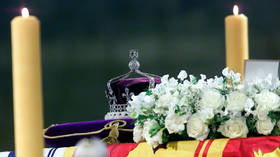India’s quest to bring antiquities back home

Weeks after Indian Prime Minister Narendra Modi visited Washington, the US handed over 105 antiquities to the Indian Consulate in New York. This is seen as New Delhi’s latest achievement in its hunt for national treasures that were looted by colonizers, and more recently – stolen from India and sold in the West.
In the 86th edition of ‘Mann ki Baat’ aired in February 2022, Indian Prime Minister Narendra Modi’s monthly radio program in which he interacts with the public on issues of national importance, he said that India has managed to bring back over 200 precious idols since he came to power in 2014. They were either stolen or smuggled to the West. He hailed this achievement, claiming that only 13 relics had been retrieved by India before 2014. Modi attributed the “change of heart” of colonizing Western powers to India’s growing soft power on the global stage.
‘History belongs to its geography’
The ruling Bharatiya Janata Party (BJP) is working overtime to reverse the cultural conquest of colonial British and other Western powers, who plundered India’s treasures for centuries with impunity. The Modi government has made it a diplomatic priority to bring these antiquities back home as it pursues its nationalist agenda – “history belongs to its geography.” This is also a topic for global debate between the colonial and colonized nations, as described in ‘Loot: Britain and the Benin Bronzes’ by British journalist Barnaby Phillips.
Several nations colonized in the past, including India, have been clamoring for repatriation of their antiquities housed in British museums. In a 2022 ‘Mann ki Baat’ episode, Modi touched upon the issue, citing his “responsibility towards mother India” as they are “part of the nation’s soul and faith.” Former Australian Prime Minister Tony Abbott was the first foreign leader to help Modi kickstart his cultural quest. In 2014, during a visit to India, he handed over two stolen 11th century idols of Nataraja (widely known as ‘Dancing Shiva’) and Ardhanarishwar (a half male and half female idol of Lord Shiva and his consort Parvati).
In 2021, in reply to a question in Parliament, then-Culture Minister Prahlad Patel shared details of the 36 artifacts recovered from the US, Australia, and the UK over a period of five years. Spanning centuries – from the Mauryas (321 BC to 185 BC) to the Cholas (9th Century AD to 13th Century AD) – and from across the country – Andhra Pradesh to Kashmir and West Bengal – the idols were returned voluntarily. The minister’s response came in the wake of the Netherlands government’s announcement that it would return all stolen artifacts to its former colonies. In India, the Dutch East India Company had colonies in Kozhikode, Masulipatnam, Nagapattinam, Puducherry, Serampore, and Pazhaverkadu.
Bringing gods back home
The US returned 105 items after New Delhi and Washington agreed to work on a Cultural Property Agreement that would prevent the illegal trafficking of cultural artifacts. The antiquities, made of terracotta, stone, metal, and wood, span the 2nd-3rd Century AD to the British colonial-rule in the 19th Century and encompass the diverse geographical spread of India. Around 50 hold religious significance for the majority Hindus and the minority Jains and Muslims, and the rest are of immense cultural importance.
The 47 terracotta pieces, vases and plaques date back to the 2nd and 3rd Century AD and are from Chandraketugarh, a 2,500-year-old archaeological site near Bidyadhari River in present-day West Bengal. The pieces include a plaque depicting a spiritual figure wearing bejeweled headgear and a sculpture of the Hindu god Vishnu riding Garuda, a mythical bird. Another 20 stone pieces trace their origins between the 10th and 12th century, depicting the Hindu idols Vishnu and Lakshmi, and a miniature Jain shrine. One of the pieces portrays a scene from the Samudra Manthan, the mythical churning of the ocean described in the Vishnu Purana, a Hindu religious text.
Many of these items were stolen by an American citizen of Indian origin, Subash Kapoor, who was sentenced to ten years by a Tamil Nadu court and is currently serving his term. The US authorities have indicted Kapoor for stealing artifacts that are valued at more than $100 million. Earlier in April, India was among 15 countries whose artifacts were returned by the US Immigrations and Customs Enforcement’s (ICE) Homeland Security Investigations’ mission. Data shows that the US has returned 278 artifacts to India, including 16 in 2016 and 157 in 2021.
Citizens’ movement
The Modi government’s diplomatic breakthrough received a force multiplier in a civil society initiative concerned with “national pride and security.” Since 2013, the India Pride Project, a citizens’ movement for the repatriation of stolen and smuggled antiquities from public museums and private collectors across the world, has been doing a great deal of work.
The movement was co-founded by public policy expert Anuraag Saxena, a Singapore-based non-resident Indian, and shipping company executive S. Vijay Kumar, who lives in Chennai, Tamil Nadu. Even before the India Pride Project, which has around 300 anonymous global teams of volunteers from all walks of life and who communicate mostly virtually, came to fruition, Kumar had already spent over a decade on this mission.
Since its inception, the project’s volunteers have brought back to India several millions worth of antiquities from across the world, including Australia, Singapore, Germany, and the US, Saxena told RT. The fledgling organization’s core team has 11 people, who are giving wings to the Modi government’s ‘decolonization’ bid. “India cannot be called a decolonized nation unless the nation can rightfully claim its precious treasures,” Saxena said. The movement aims to bring back both those artifacts taken forcibly out of India during the British colonial era, and those stolen and smuggled from temples and public collections more recently.
Saxena argued that “in a flatter, more transparent world, nations (read Western) will have to give up the aggressive, loot-and-scoot view of another’s heritage,” while citing how “India has been a victim to colonizers and mercenaries for centuries. Let’s not forget Christopher Columbus was looking for India when he lost his way to America.”
The volunteers are optimistic about the road ahead, despite the scarcity of resources. “There has been an institutionalized destruction of Indian culture since independence. Over 70 years of rust will take time to clean,” he said, adding, “we have zero employees, zero authority, and zero funding. Imagine what we could achieve with the right institutional support.”
Saxena hailed the organization’s efforts of two years ago which aided an investigation and convinced the National Gallery of Australia to return 14 artifacts worth $2.2 million, which were stolen by Kapoor, to the Indian government. “Magic happens when the right intent comes together,” he said. There was another feather in the project’s cap in 2015, when German Chancellor Angela Merkel visited India. She handed over to Modi a stolen heritage Durga idol as a goodwill gesture. The idol was stolen from India and sold to a German museum at a cost of $250,000. Now, the project seeks to restore India’s pride and heritage glory – one precious piece at a time – despite a gaping regulatory lacuna.
Heritage laws
India failed to retrieve stolen artifacts after it gained independence from the British in 1947 largely because it lacks strict regulations, experts say. Restitution has been rare in the absence of foolproof regulatory measures. The Antiquities and Art Treasures Act of 1972, which was implemented on April 1, 1976, has largely remained a paper tiger, unlike, for example, the stringent US Federal Historic Preservation Laws, despite the country’s rich historical past, Saxena said. China, another ancient civilization like India, has introduced regulations to safeguard its heritage.
Saxena explained that “not-so-prosperous countries such as Jordan and Mexico have robust regulations, while a more economically-advanced nation such as India is found lacking owing to a policy paralysis of successive governments in the past. Jordan’s GDP is less than 2% of India’s, but it still has a stringent enforcement agency unlike ours.”
How Britain stole $45 trillion from India
The British, which ruled India for nearly 200 years between 1757 and 1947, has perpetuated the narrative that governing the undivided country was a gesture of London’s benevolence. However, a research paper by economist Utsa Patnaik published by Columbia University Press in 2019 debunks that long-held narrative.
Patnaik’s research – based on exhaustive data on tax and trade – revealed that Britain robbed India of around $45 trillion between 1765 and 1938. As a comparative figure, the UK’s present-day economy – the sixth-largest in the world – is estimated at $3.16 trillion, around 15 times less than what it had systematically plundered from India, including the precious 105.6 carat crown jewel Koh-i-Noor, which loosely translates to ‘Mountain of Light’ from Persian. Indian Minister for External Affairs Dr. Subrahmanyam Jaishankar endorsed Patnaik’s findings.
The Guardian uncovered from Britain’s ‘India Office’ archives how priceless items from the colony – known as the ‘Jewel in the Crown’ – were “extracted as trophies of conquest.” The 46-page file, which dates back to 1912, revealed an investigation ordered by Queen Mary (Queen Elizabeth’s grandmother) into the “imperial origins of her jewels.”
Shashi Tharoor, formerly an undersecretary at the United Nations and currently a three-term member of Parliament, told The Guardian, “We have finally entered an era where colonial loot and pillage is being recognized for what it really was, rather than being dressed up as the incidental spoils of some noble ‘civilizing mission.’” The Congress MP echoed similar thoughts in another Indian documentary, ‘Blood Buddha – Bringing Our Gods Home’: “they [the British] didn’t steal them because they could look after them better; they stole them first and found the justification later.”
An RT documentary, ‘Looted India: Cost of an Empire’, lays bare individuals’ struggle to retrieve their family jewels and precious possessions, while India’s lack of legal provisions continues to plague individuals. The documentary showcases the family history of Jarat Chopra, a British-Indian legal professional who lives in Nairobi, Kenya. He is the last male descendant of Diwan Mulraj, the erstwhile ruler of Multan, a kingdom that was a part of the Sikh empire under Maharaja Ranjit Singh between 1799 and 1849.
Chopra left no stone unturned for the return of his ancestor’s sword, taken by British officer William Whish in the Second Anglo-Sikh War in 1849. He discovered that his family’s treasure was lying in the Royal Artillery Institute in Woolwich in 2020. However, despite his efforts, the institution has refused to return the sword, claiming it was a spoil of war. Chopra’s disappointment is part of a larger narrative of the UK’s routine stonewalling of India’s pleas to retrieve its treasures under the pretext of the British Museum Act of 1963.
Fortunately, a section of intelligentsia in the UK has turned their gaze on imperialistic designs. Historian William Dalrymple’s book ‘The Anarchy: How a Corporation Replaced the Mughal Empire, 1756-1803’ and ‘Koh-i-Noor: The History of the World’s Most Infamous Diamond’, which he co-authored with Anita Anand, offer a peek into the ‘loot-and scoot’ theory that Saxena talked about. Though the monetary value of these antiquities that sit pretty in the British Museum, the Pitt Rivers Museum, the Victoria and Albert Museum, and several other art houses and galleries in the Western capitals cannot be quantified in absolute terms, the Modi administration’s initiative – aided by the project’s volunteers – is a step towards cultural restitution and reclaiming a slice of history.
Joydeep Sen Gupta, Asia Editor















